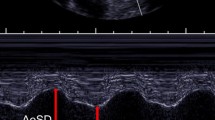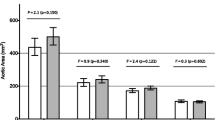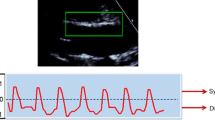Abstract
The purpose of this study was to investigate whether large arteries in subjects with Ehlers-Danlos Syndrome Type IV (EDS IV) exhibit altered morphological and functional characteristics that might indicate the risk of complications. Subjects with EDS IV, an inherited disorder of type III collagen, have a significant lifetime risk of arterial rupture. Magnetic Resonance Imaging (MRI) of the aorta and carotid artery was used to measure diameter, wall thickness, pulse propagation velocity, and spin-spin relaxation time constant (T 2) of the artery walls. These measurements were made and compared by a two-sided t-test in 17 subjects with EDS IV and in eight age and gender matched sibling controls. Additionally, Spearman correlation was computed between measurements and the average longevity of affected relatives. Comparing controls to 15 subjects with no known prior aortic complications, we found no differences in the diameters of the descending thoracic and abdominal aortas, but did find ascending aorta dilatation in two subjects (13%). We also found a trend in EDS IV subjects toward higher wall thicknesses after normalizing by body surface area for both the abdominal aorta (P = 0.05) and the common carotid artery (P = 0.07). Finally, we found a significant negative correlation (R = −0.82, P = 0.02) between age-adjusted pulse propagation velocity and familial longevity. In conclusion, preliminary evidence suggests that elevated pulse propagation velocity, which indicates reduced vessel distensibility, may be a risk factor for complications of EDS IV. Ascending aorta dilatation and increased vessel wall thickness were also found in subjects with EDS IV and represent potential risk factors for future study.







Similar content being viewed by others
Abbreviations
- EDS:
-
Ehlers-Danlos syndrome
- BSA:
-
Body surface area
- ADR:
-
Aorta diameter ratio
- PPV:
-
Pulse propagation velocity
- IMT:
-
Intima-media thickness
References
Pepin M, Schwarze U, Superti-Furga A, Byers PH (2000) Clinical and genetic features of Ehlers-Danlos syndrome type IV, the vascular type. N Engl J Med 342:673–680
Crowther MA, Lach B, Dunmore PJ, Roach MR (1991) Vascular collagen fibril morphology in type IV Ehlers-Danlos syndrome. Connect Tissue Res 25:209–217
Nerlich AG, Stoss H, Lehmann H, Krieg T, Muller PK (1994) Pathomorphological and biochemical alterations in Ehlers-Danlos-syndrome type IV. Pathol Res Pract 190:697–706
Laurent S, Boutouyrie P, Lacolley P (2005) Structural and genetic bases of arterial stiffness. Hypertension 45:1050–1055
McDonnell NB, Gorman BL, Mandel KW, Schurman SH, Assanah-Carroll A, Mayer SA, Najjar SS, Francomano CA (2006) Echocardiographic findings in classical and hypermobile Ehlers-Danlos syndromes. Am J Med Genet A 140:129–136
Yen JL, Lin SP, Chen MR, Niu DM (2006) Clinical features of Ehlers-Danlos syndrome. J Formos Med Assoc 105:475–480
Sonesson B, Hansen F, Lanne T (1997) The mechanical properties of elastic arteries in Ehlers-Danlos syndrome. Eur J Vasc Endovasc Surg 14:258–264
Wenstrup RJ, Meyer RA, Lyle JS, Hoechstetter L, Rose PS, Levy HP, Francomano CA (2002) Prevalence of aortic root dilation in the Ehlers-Danlos syndrome. Genet Med 4:112–117
Boutouyrie P, Germain DP, Fiessinger JN, Laloux B, Perdu J, Laurent S (2004) Increased carotid wall stress in vascular Ehlers-Danlos syndrome. Circulation 109:1530–1535
Underhill HR, Kerwin WS, Hatsukami TS, Yuan C (2006) Automated measurement of mean wall thickness in the common carotid artery by MRI: a comparison to intima-media thickness by B-mode ultrasound. J Magn Reson Imaging 24:379–387
Mohiaddin RH, Firmin DN, Longmore DB (1993) Age-related changes of human aortic flow wave velocity measured noninvasively by magnetic resonance imaging. J Appl Physiol 74:492–497
Yuan C, Kerwin WS (2004) MRI of atherosclerosis. J Magn Reson Imaging 19:710–719
Mosteller RD (1987) Simplified calculation of body-surface area. N Engl J Med 317:1098
Johnston KW, Rutherford RB, Tilson MD, Shah DM, Hollier L, Stanley JC (1991) Suggested standards for reporting on arterial aneurysms. Subcommittee on Reporting Standards for Arterial Aneurysms, Ad Hoc Committee on Reporting Standards, Society for Vascular Surgery and North American Chapter, International Society for Cardiovascular Surgery. J Vasc Surg 13:452–458
Kerwin W, Xu D, Liu F, Saam T, Underhill H, Takaya N, Chu B, Hatsukami T, Yuan C (2007) Magnetic resonance imaging of carotid atherosclerosis: plaque analysis. Top Magn Reson Imaging 18:371–378
Dolan AL, Mishra MB, Chambers JB, Grahame R (1997) Clinical and echocardiographic survey of the Ehlers-Danlos syndrome. Br J Rheumatol 36:459–462
Nollen GJ, Groenink M, Tijssen JG, Van Der Wall EE, Mulder BJ (2004) Aortic stiffness and diameter predict progressive aortic dilatation in patients with Marfan syndrome. Eur Heart J 25:1146–1152
Meijboom LJ, Timmermans J, Zwinderman AH, Engelfriet PM, Mulder BJ (2005) Aortic root growth in men and women with the Marfan’s syndrome. Am J Cardiol 96:1441–1444
Baumgartner D, Baumgartner C, Schermer E, Engl G, Schweigmann U, Matyas G, Steinmann B, Stein JI (2006) Different patterns of aortic wall elasticity in patients with Marfan syndrome: a noninvasive follow-up study. J Thorac Cardiovasc Surg 132:811–819
Meijboom LJ, Groenink M, van der Wall EE, Romkes H, Stoker J, Mulder BJM (2000) Aortic root asymmetry in Marfan patients; evaluation by magnetic resonance imaging and comparison with standard echocardiography. Int J Card Imaging 16:161–168
Ho VB, Prince MR, Dong Q (1999) Magnetic resonance imaging of the aorta and branch vessels. Coron Artery Dis 10:141–149
Leeson CP, Robinson M, Francis JM, Robson MD, Channon KM, Neubauer S, Wiesmann F (2006) Cardiovascular magnetic resonance imaging for non-invasive assessment of vascular function: validation against ultrasound. J Cardiovasc Magn Reson 8:381–387
Acknowledgements
Grant Support: National Organization for Rare Disorders (Danbury, CT), Ehlers-Danlos National Foundation (Los Angeles, CA).
Author information
Authors and Affiliations
Corresponding author
Rights and permissions
About this article
Cite this article
Kerwin, W., Pepin, M., Mitsumori, L. et al. MRI of great vessel morphology and function in Ehlers-Danlos syndrome type IV. Int J Cardiovasc Imaging 24, 519–528 (2008). https://doi.org/10.1007/s10554-007-9283-z
Received:
Accepted:
Published:
Issue Date:
DOI: https://doi.org/10.1007/s10554-007-9283-z




